UGB165: Toyota's Risk Management Strategies and Operations Analysis
VerifiedAdded on 2023/06/07
|11
|3820
|406
Report
AI Summary
This report analyzes Toyota's risk management strategies and company-wide operations improvement strategies. It explores risk management processes such as risk identification, assessment, response, and monitoring, along with strategies like avoidance, retention, sharing, transferring, and loss prevention. The report also discusses company-wide operations improvement strategies, including investing in technology, embracing automation, providing continuous training, iterating and measuring metrics. The analysis aims to provide insights into how Toyota can withstand shocks and improve its operational efficiency by leveraging various tools and techniques learned in the UGB165 module. The report also references the opportunity for Ford and GM to capitalize on Toyota's challenges by improving their auto lineups.
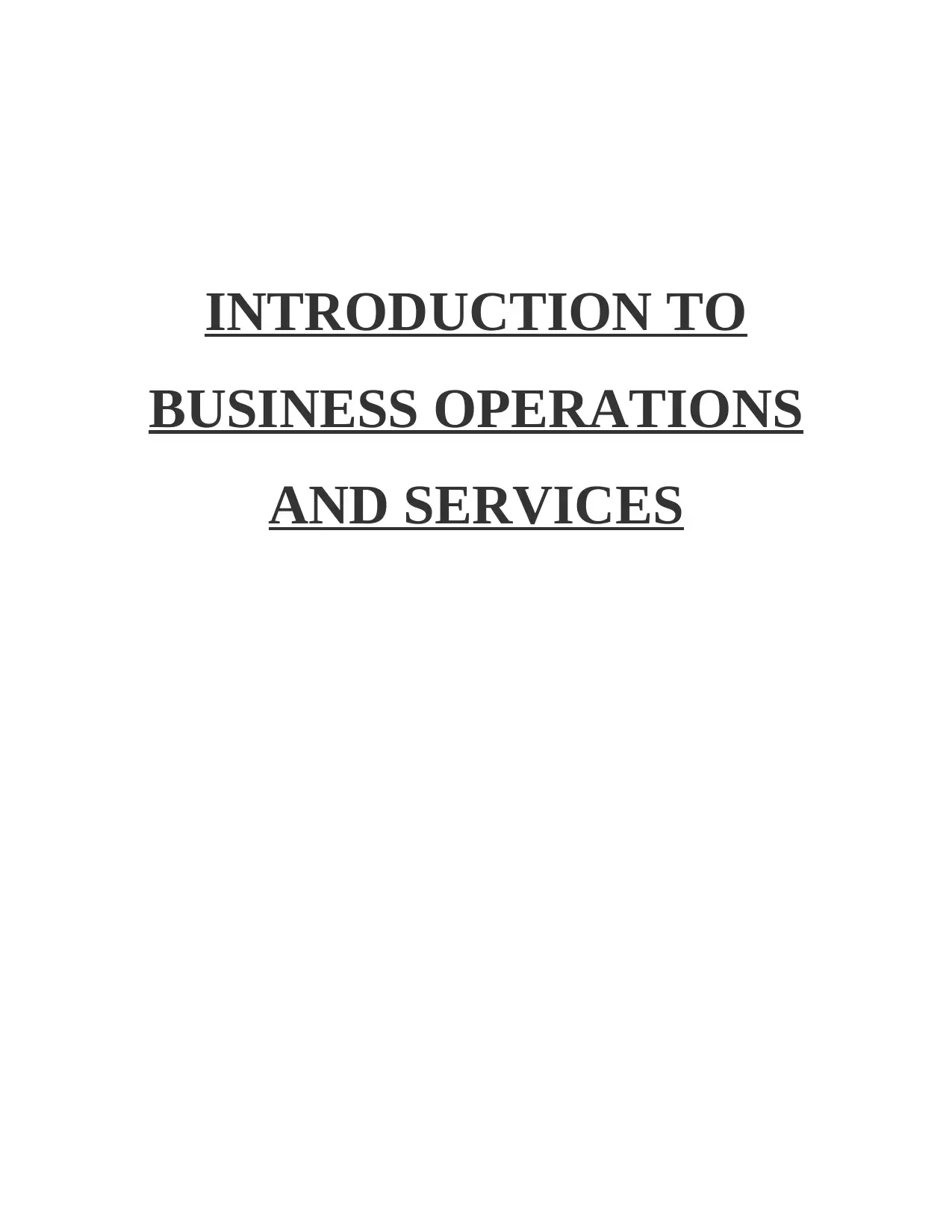
INTRODUCTION TO
BUSINESS OPERATIONS
AND SERVICES
BUSINESS OPERATIONS
AND SERVICES
Paraphrase This Document
Need a fresh take? Get an instant paraphrase of this document with our AI Paraphraser
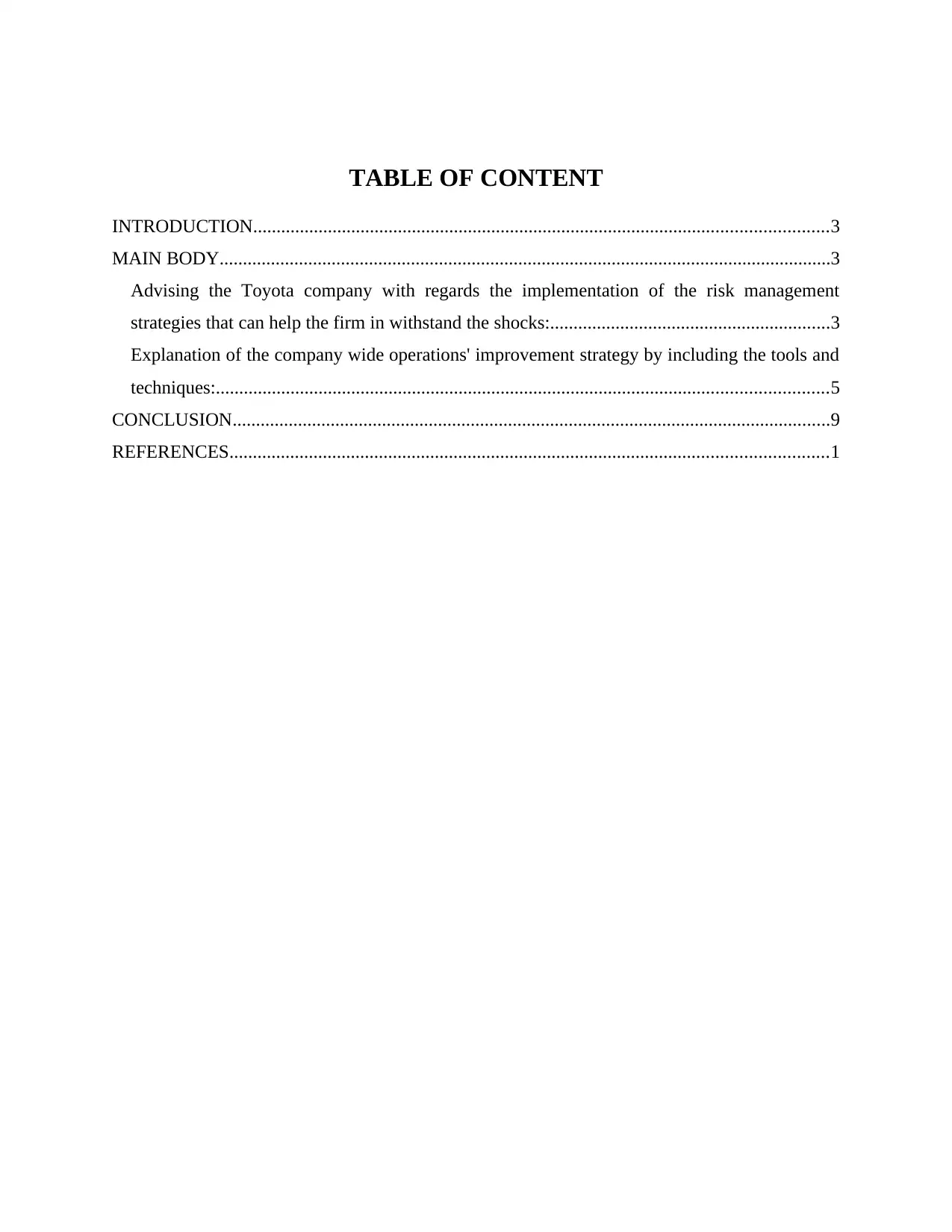
TABLE OF CONTENT
INTRODUCTION...........................................................................................................................3
MAIN BODY...................................................................................................................................3
Advising the Toyota company with regards the implementation of the risk management
strategies that can help the firm in withstand the shocks:............................................................3
Explanation of the company wide operations' improvement strategy by including the tools and
techniques:...................................................................................................................................5
CONCLUSION................................................................................................................................9
REFERENCES................................................................................................................................1
INTRODUCTION...........................................................................................................................3
MAIN BODY...................................................................................................................................3
Advising the Toyota company with regards the implementation of the risk management
strategies that can help the firm in withstand the shocks:............................................................3
Explanation of the company wide operations' improvement strategy by including the tools and
techniques:...................................................................................................................................5
CONCLUSION................................................................................................................................9
REFERENCES................................................................................................................................1
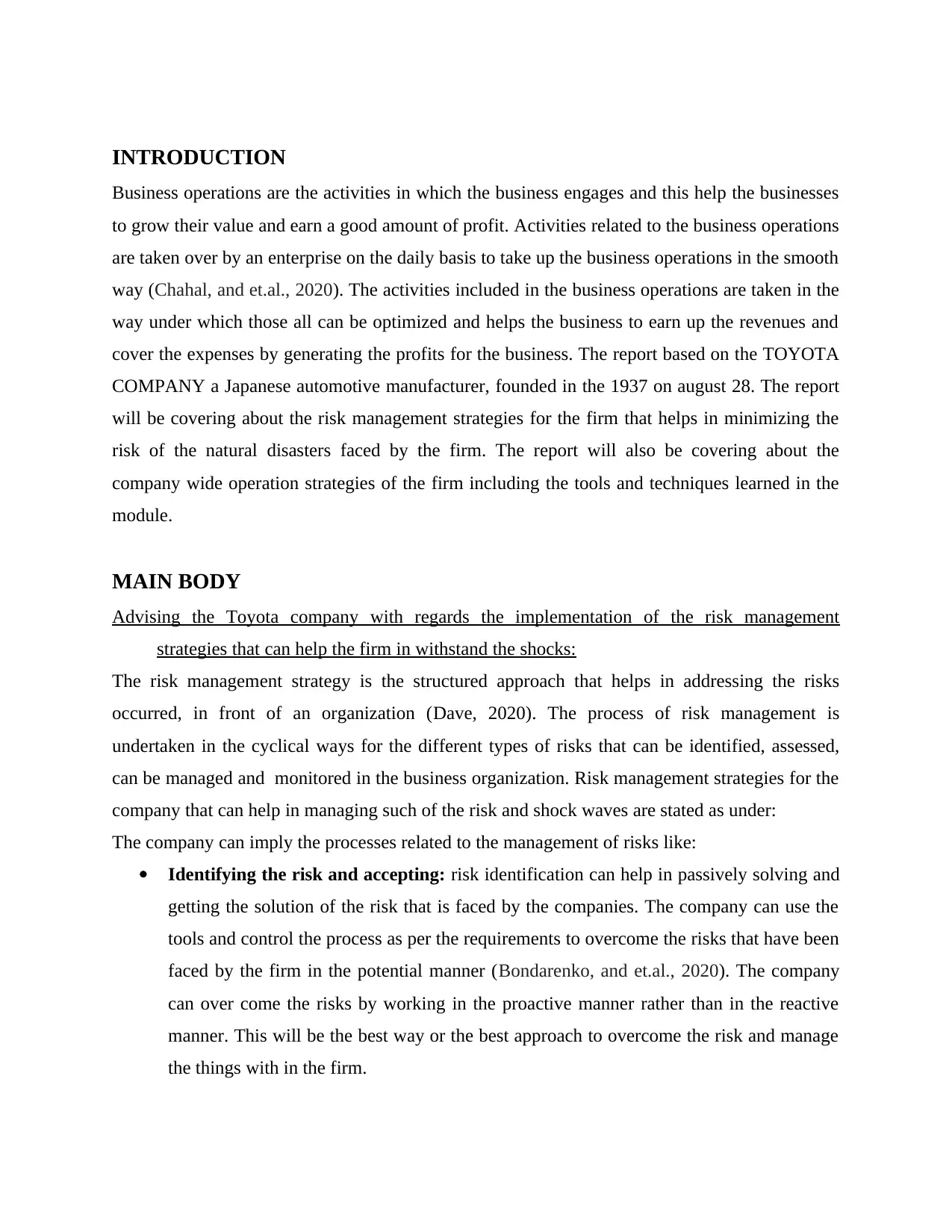
INTRODUCTION
Business operations are the activities in which the business engages and this help the businesses
to grow their value and earn a good amount of profit. Activities related to the business operations
are taken over by an enterprise on the daily basis to take up the business operations in the smooth
way (Chahal, and et.al., 2020). The activities included in the business operations are taken in the
way under which those all can be optimized and helps the business to earn up the revenues and
cover the expenses by generating the profits for the business. The report based on the TOYOTA
COMPANY a Japanese automotive manufacturer, founded in the 1937 on august 28. The report
will be covering about the risk management strategies for the firm that helps in minimizing the
risk of the natural disasters faced by the firm. The report will also be covering about the
company wide operation strategies of the firm including the tools and techniques learned in the
module.
MAIN BODY
Advising the Toyota company with regards the implementation of the risk management
strategies that can help the firm in withstand the shocks:
The risk management strategy is the structured approach that helps in addressing the risks
occurred, in front of an organization (Dave, 2020). The process of risk management is
undertaken in the cyclical ways for the different types of risks that can be identified, assessed,
can be managed and monitored in the business organization. Risk management strategies for the
company that can help in managing such of the risk and shock waves are stated as under:
The company can imply the processes related to the management of risks like:
Identifying the risk and accepting: risk identification can help in passively solving and
getting the solution of the risk that is faced by the companies. The company can use the
tools and control the process as per the requirements to overcome the risks that have been
faced by the firm in the potential manner (Bondarenko, and et.al., 2020). The company
can over come the risks by working in the proactive manner rather than in the reactive
manner. This will be the best way or the best approach to overcome the risk and manage
the things with in the firm.
Business operations are the activities in which the business engages and this help the businesses
to grow their value and earn a good amount of profit. Activities related to the business operations
are taken over by an enterprise on the daily basis to take up the business operations in the smooth
way (Chahal, and et.al., 2020). The activities included in the business operations are taken in the
way under which those all can be optimized and helps the business to earn up the revenues and
cover the expenses by generating the profits for the business. The report based on the TOYOTA
COMPANY a Japanese automotive manufacturer, founded in the 1937 on august 28. The report
will be covering about the risk management strategies for the firm that helps in minimizing the
risk of the natural disasters faced by the firm. The report will also be covering about the
company wide operation strategies of the firm including the tools and techniques learned in the
module.
MAIN BODY
Advising the Toyota company with regards the implementation of the risk management
strategies that can help the firm in withstand the shocks:
The risk management strategy is the structured approach that helps in addressing the risks
occurred, in front of an organization (Dave, 2020). The process of risk management is
undertaken in the cyclical ways for the different types of risks that can be identified, assessed,
can be managed and monitored in the business organization. Risk management strategies for the
company that can help in managing such of the risk and shock waves are stated as under:
The company can imply the processes related to the management of risks like:
Identifying the risk and accepting: risk identification can help in passively solving and
getting the solution of the risk that is faced by the companies. The company can use the
tools and control the process as per the requirements to overcome the risks that have been
faced by the firm in the potential manner (Bondarenko, and et.al., 2020). The company
can over come the risks by working in the proactive manner rather than in the reactive
manner. This will be the best way or the best approach to overcome the risk and manage
the things with in the firm.
⊘ This is a preview!⊘
Do you want full access?
Subscribe today to unlock all pages.

Trusted by 1+ million students worldwide
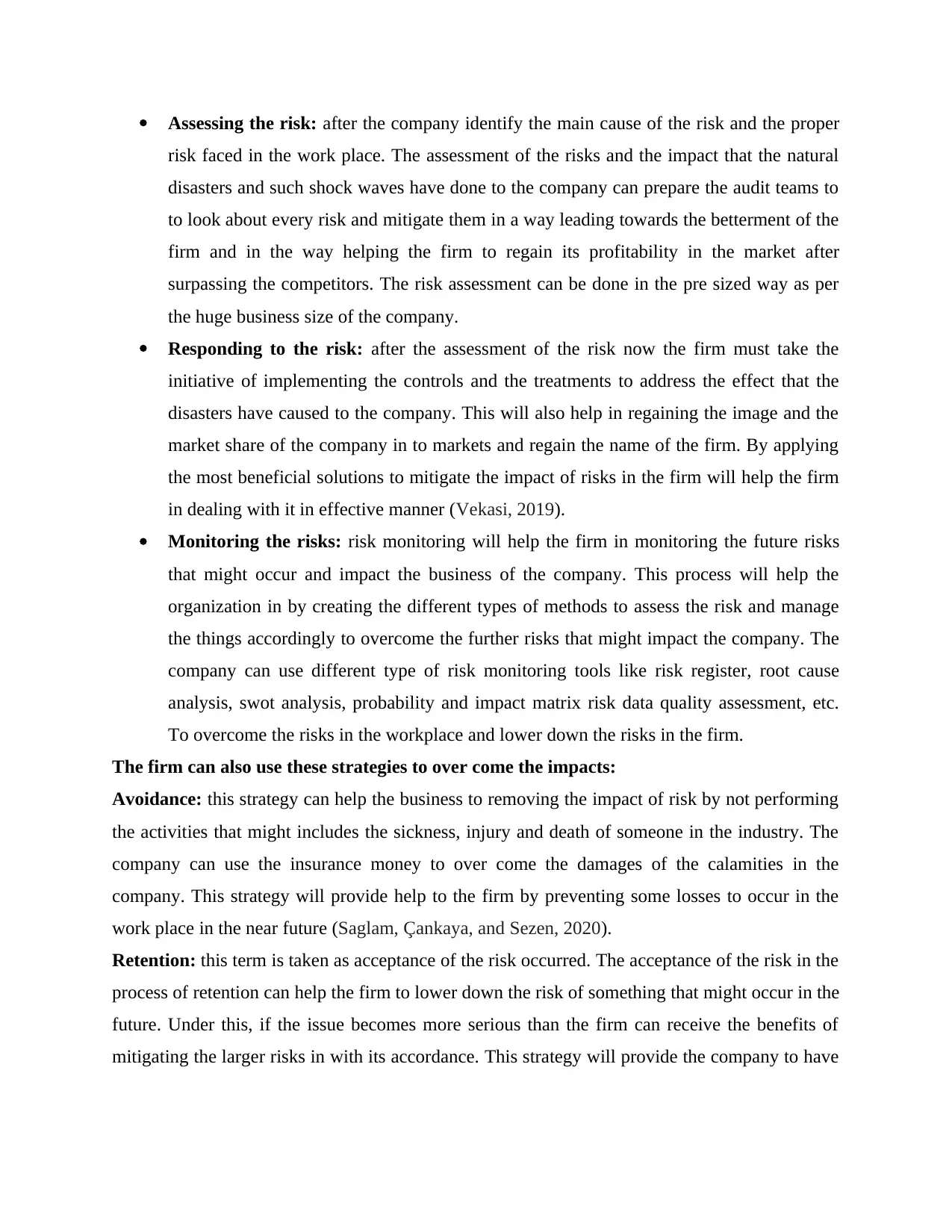
Assessing the risk: after the company identify the main cause of the risk and the proper
risk faced in the work place. The assessment of the risks and the impact that the natural
disasters and such shock waves have done to the company can prepare the audit teams to
to look about every risk and mitigate them in a way leading towards the betterment of the
firm and in the way helping the firm to regain its profitability in the market after
surpassing the competitors. The risk assessment can be done in the pre sized way as per
the huge business size of the company.
Responding to the risk: after the assessment of the risk now the firm must take the
initiative of implementing the controls and the treatments to address the effect that the
disasters have caused to the company. This will also help in regaining the image and the
market share of the company in to markets and regain the name of the firm. By applying
the most beneficial solutions to mitigate the impact of risks in the firm will help the firm
in dealing with it in effective manner (Vekasi, 2019).
Monitoring the risks: risk monitoring will help the firm in monitoring the future risks
that might occur and impact the business of the company. This process will help the
organization in by creating the different types of methods to assess the risk and manage
the things accordingly to overcome the further risks that might impact the company. The
company can use different type of risk monitoring tools like risk register, root cause
analysis, swot analysis, probability and impact matrix risk data quality assessment, etc.
To overcome the risks in the workplace and lower down the risks in the firm.
The firm can also use these strategies to over come the impacts:
Avoidance: this strategy can help the business to removing the impact of risk by not performing
the activities that might includes the sickness, injury and death of someone in the industry. The
company can use the insurance money to over come the damages of the calamities in the
company. This strategy will provide help to the firm by preventing some losses to occur in the
work place in the near future (Saglam, Çankaya, and Sezen, 2020).
Retention: this term is taken as acceptance of the risk occurred. The acceptance of the risk in the
process of retention can help the firm to lower down the risk of something that might occur in the
future. Under this, if the issue becomes more serious than the firm can receive the benefits of
mitigating the larger risks in with its accordance. This strategy will provide the company to have
risk faced in the work place. The assessment of the risks and the impact that the natural
disasters and such shock waves have done to the company can prepare the audit teams to
to look about every risk and mitigate them in a way leading towards the betterment of the
firm and in the way helping the firm to regain its profitability in the market after
surpassing the competitors. The risk assessment can be done in the pre sized way as per
the huge business size of the company.
Responding to the risk: after the assessment of the risk now the firm must take the
initiative of implementing the controls and the treatments to address the effect that the
disasters have caused to the company. This will also help in regaining the image and the
market share of the company in to markets and regain the name of the firm. By applying
the most beneficial solutions to mitigate the impact of risks in the firm will help the firm
in dealing with it in effective manner (Vekasi, 2019).
Monitoring the risks: risk monitoring will help the firm in monitoring the future risks
that might occur and impact the business of the company. This process will help the
organization in by creating the different types of methods to assess the risk and manage
the things accordingly to overcome the further risks that might impact the company. The
company can use different type of risk monitoring tools like risk register, root cause
analysis, swot analysis, probability and impact matrix risk data quality assessment, etc.
To overcome the risks in the workplace and lower down the risks in the firm.
The firm can also use these strategies to over come the impacts:
Avoidance: this strategy can help the business to removing the impact of risk by not performing
the activities that might includes the sickness, injury and death of someone in the industry. The
company can use the insurance money to over come the damages of the calamities in the
company. This strategy will provide help to the firm by preventing some losses to occur in the
work place in the near future (Saglam, Çankaya, and Sezen, 2020).
Retention: this term is taken as acceptance of the risk occurred. The acceptance of the risk in the
process of retention can help the firm to lower down the risk of something that might occur in the
future. Under this, if the issue becomes more serious than the firm can receive the benefits of
mitigating the larger risks in with its accordance. This strategy will provide the company to have
Paraphrase This Document
Need a fresh take? Get an instant paraphrase of this document with our AI Paraphraser
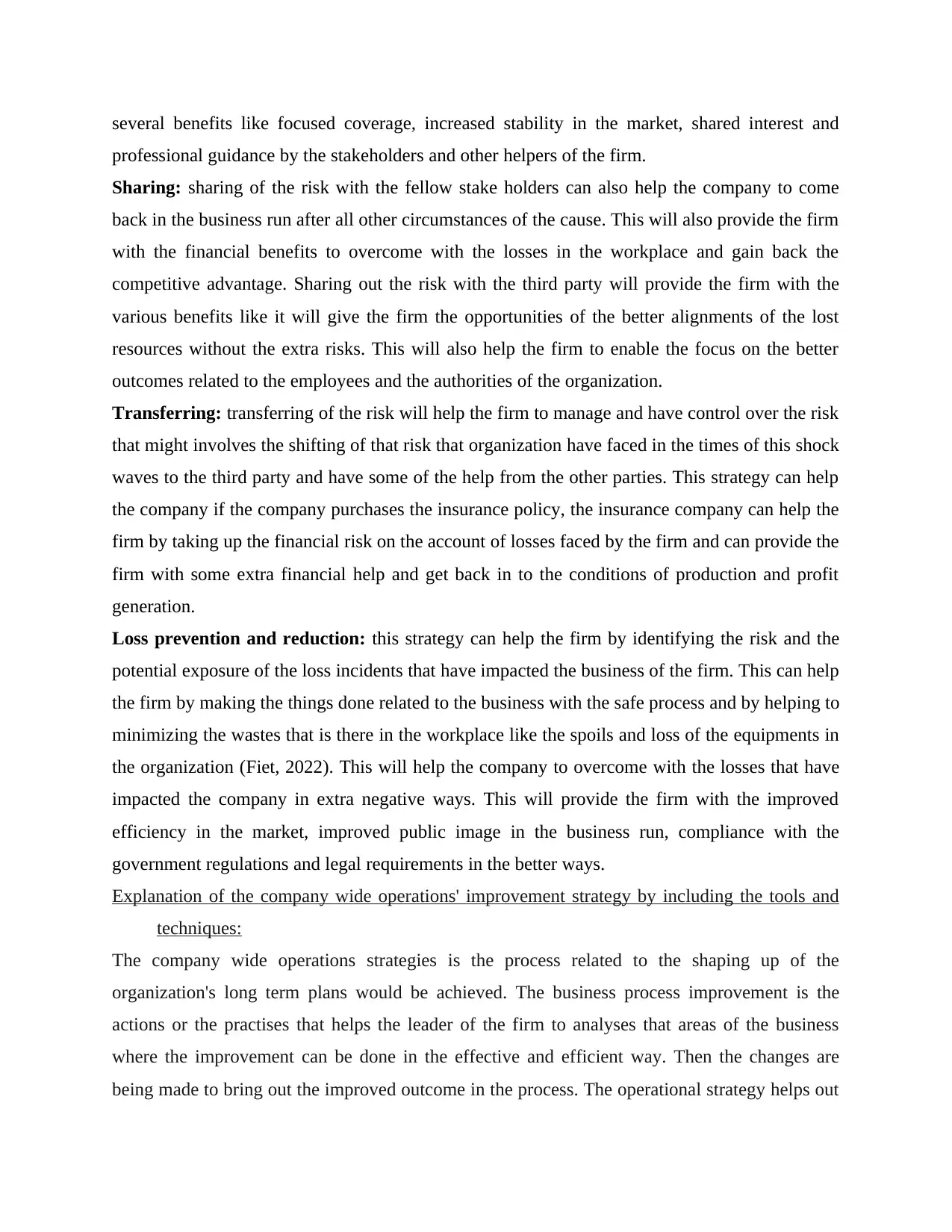
several benefits like focused coverage, increased stability in the market, shared interest and
professional guidance by the stakeholders and other helpers of the firm.
Sharing: sharing of the risk with the fellow stake holders can also help the company to come
back in the business run after all other circumstances of the cause. This will also provide the firm
with the financial benefits to overcome with the losses in the workplace and gain back the
competitive advantage. Sharing out the risk with the third party will provide the firm with the
various benefits like it will give the firm the opportunities of the better alignments of the lost
resources without the extra risks. This will also help the firm to enable the focus on the better
outcomes related to the employees and the authorities of the organization.
Transferring: transferring of the risk will help the firm to manage and have control over the risk
that might involves the shifting of that risk that organization have faced in the times of this shock
waves to the third party and have some of the help from the other parties. This strategy can help
the company if the company purchases the insurance policy, the insurance company can help the
firm by taking up the financial risk on the account of losses faced by the firm and can provide the
firm with some extra financial help and get back in to the conditions of production and profit
generation.
Loss prevention and reduction: this strategy can help the firm by identifying the risk and the
potential exposure of the loss incidents that have impacted the business of the firm. This can help
the firm by making the things done related to the business with the safe process and by helping to
minimizing the wastes that is there in the workplace like the spoils and loss of the equipments in
the organization (Fiet, 2022). This will help the company to overcome with the losses that have
impacted the company in extra negative ways. This will provide the firm with the improved
efficiency in the market, improved public image in the business run, compliance with the
government regulations and legal requirements in the better ways.
Explanation of the company wide operations' improvement strategy by including the tools and
techniques:
The company wide operations strategies is the process related to the shaping up of the
organization's long term plans would be achieved. The business process improvement is the
actions or the practises that helps the leader of the firm to analyses that areas of the business
where the improvement can be done in the effective and efficient way. Then the changes are
being made to bring out the improved outcome in the process. The operational strategy helps out
professional guidance by the stakeholders and other helpers of the firm.
Sharing: sharing of the risk with the fellow stake holders can also help the company to come
back in the business run after all other circumstances of the cause. This will also provide the firm
with the financial benefits to overcome with the losses in the workplace and gain back the
competitive advantage. Sharing out the risk with the third party will provide the firm with the
various benefits like it will give the firm the opportunities of the better alignments of the lost
resources without the extra risks. This will also help the firm to enable the focus on the better
outcomes related to the employees and the authorities of the organization.
Transferring: transferring of the risk will help the firm to manage and have control over the risk
that might involves the shifting of that risk that organization have faced in the times of this shock
waves to the third party and have some of the help from the other parties. This strategy can help
the company if the company purchases the insurance policy, the insurance company can help the
firm by taking up the financial risk on the account of losses faced by the firm and can provide the
firm with some extra financial help and get back in to the conditions of production and profit
generation.
Loss prevention and reduction: this strategy can help the firm by identifying the risk and the
potential exposure of the loss incidents that have impacted the business of the firm. This can help
the firm by making the things done related to the business with the safe process and by helping to
minimizing the wastes that is there in the workplace like the spoils and loss of the equipments in
the organization (Fiet, 2022). This will help the company to overcome with the losses that have
impacted the company in extra negative ways. This will provide the firm with the improved
efficiency in the market, improved public image in the business run, compliance with the
government regulations and legal requirements in the better ways.
Explanation of the company wide operations' improvement strategy by including the tools and
techniques:
The company wide operations strategies is the process related to the shaping up of the
organization's long term plans would be achieved. The business process improvement is the
actions or the practises that helps the leader of the firm to analyses that areas of the business
where the improvement can be done in the effective and efficient way. Then the changes are
being made to bring out the improved outcome in the process. The operational strategy helps out
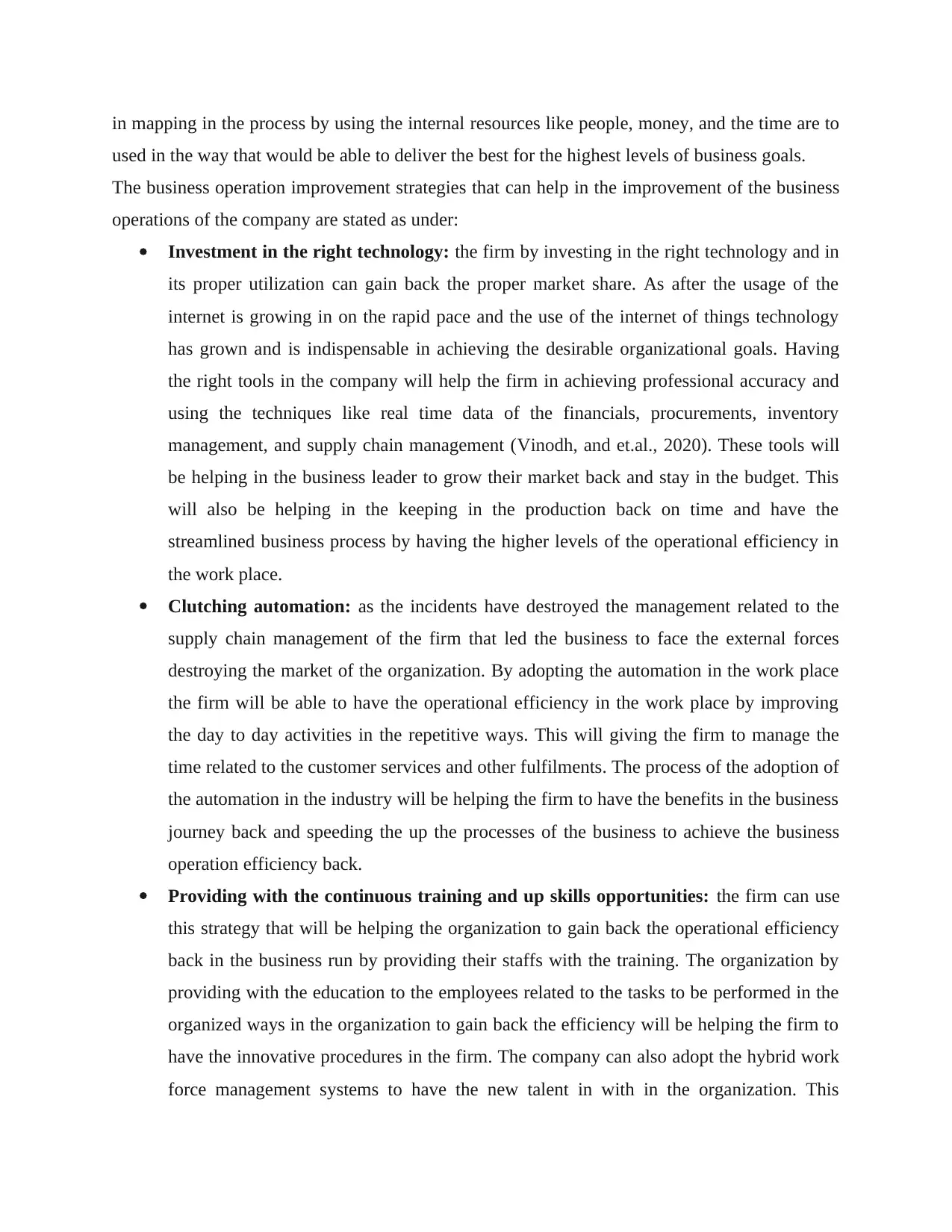
in mapping in the process by using the internal resources like people, money, and the time are to
used in the way that would be able to deliver the best for the highest levels of business goals.
The business operation improvement strategies that can help in the improvement of the business
operations of the company are stated as under:
Investment in the right technology: the firm by investing in the right technology and in
its proper utilization can gain back the proper market share. As after the usage of the
internet is growing in on the rapid pace and the use of the internet of things technology
has grown and is indispensable in achieving the desirable organizational goals. Having
the right tools in the company will help the firm in achieving professional accuracy and
using the techniques like real time data of the financials, procurements, inventory
management, and supply chain management (Vinodh, and et.al., 2020). These tools will
be helping in the business leader to grow their market back and stay in the budget. This
will also be helping in the keeping in the production back on time and have the
streamlined business process by having the higher levels of the operational efficiency in
the work place.
Clutching automation: as the incidents have destroyed the management related to the
supply chain management of the firm that led the business to face the external forces
destroying the market of the organization. By adopting the automation in the work place
the firm will be able to have the operational efficiency in the work place by improving
the day to day activities in the repetitive ways. This will giving the firm to manage the
time related to the customer services and other fulfilments. The process of the adoption of
the automation in the industry will be helping the firm to have the benefits in the business
journey back and speeding the up the processes of the business to achieve the business
operation efficiency back.
Providing with the continuous training and up skills opportunities: the firm can use
this strategy that will be helping the organization to gain back the operational efficiency
back in the business run by providing their staffs with the training. The organization by
providing with the education to the employees related to the tasks to be performed in the
organized ways in the organization to gain back the efficiency will be helping the firm to
have the innovative procedures in the firm. The company can also adopt the hybrid work
force management systems to have the new talent in with in the organization. This
used in the way that would be able to deliver the best for the highest levels of business goals.
The business operation improvement strategies that can help in the improvement of the business
operations of the company are stated as under:
Investment in the right technology: the firm by investing in the right technology and in
its proper utilization can gain back the proper market share. As after the usage of the
internet is growing in on the rapid pace and the use of the internet of things technology
has grown and is indispensable in achieving the desirable organizational goals. Having
the right tools in the company will help the firm in achieving professional accuracy and
using the techniques like real time data of the financials, procurements, inventory
management, and supply chain management (Vinodh, and et.al., 2020). These tools will
be helping in the business leader to grow their market back and stay in the budget. This
will also be helping in the keeping in the production back on time and have the
streamlined business process by having the higher levels of the operational efficiency in
the work place.
Clutching automation: as the incidents have destroyed the management related to the
supply chain management of the firm that led the business to face the external forces
destroying the market of the organization. By adopting the automation in the work place
the firm will be able to have the operational efficiency in the work place by improving
the day to day activities in the repetitive ways. This will giving the firm to manage the
time related to the customer services and other fulfilments. The process of the adoption of
the automation in the industry will be helping the firm to have the benefits in the business
journey back and speeding the up the processes of the business to achieve the business
operation efficiency back.
Providing with the continuous training and up skills opportunities: the firm can use
this strategy that will be helping the organization to gain back the operational efficiency
back in the business run by providing their staffs with the training. The organization by
providing with the education to the employees related to the tasks to be performed in the
organized ways in the organization to gain back the efficiency will be helping the firm to
have the innovative procedures in the firm. The company can also adopt the hybrid work
force management systems to have the new talent in with in the organization. This
⊘ This is a preview!⊘
Do you want full access?
Subscribe today to unlock all pages.

Trusted by 1+ million students worldwide
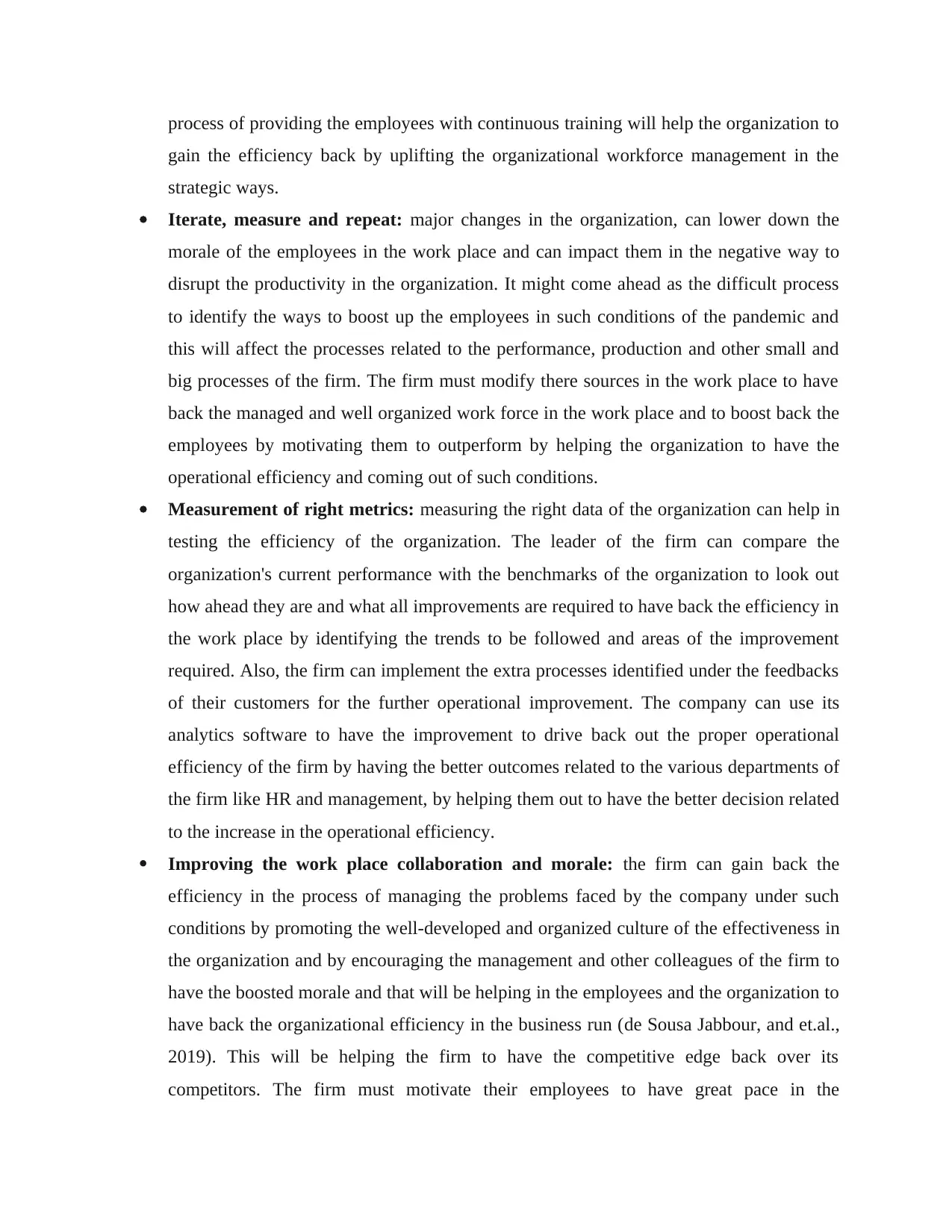
process of providing the employees with continuous training will help the organization to
gain the efficiency back by uplifting the organizational workforce management in the
strategic ways.
Iterate, measure and repeat: major changes in the organization, can lower down the
morale of the employees in the work place and can impact them in the negative way to
disrupt the productivity in the organization. It might come ahead as the difficult process
to identify the ways to boost up the employees in such conditions of the pandemic and
this will affect the processes related to the performance, production and other small and
big processes of the firm. The firm must modify there sources in the work place to have
back the managed and well organized work force in the work place and to boost back the
employees by motivating them to outperform by helping the organization to have the
operational efficiency and coming out of such conditions.
Measurement of right metrics: measuring the right data of the organization can help in
testing the efficiency of the organization. The leader of the firm can compare the
organization's current performance with the benchmarks of the organization to look out
how ahead they are and what all improvements are required to have back the efficiency in
the work place by identifying the trends to be followed and areas of the improvement
required. Also, the firm can implement the extra processes identified under the feedbacks
of their customers for the further operational improvement. The company can use its
analytics software to have the improvement to drive back out the proper operational
efficiency of the firm by having the better outcomes related to the various departments of
the firm like HR and management, by helping them out to have the better decision related
to the increase in the operational efficiency.
Improving the work place collaboration and morale: the firm can gain back the
efficiency in the process of managing the problems faced by the company under such
conditions by promoting the well-developed and organized culture of the effectiveness in
the organization and by encouraging the management and other colleagues of the firm to
have the boosted morale and that will be helping in the employees and the organization to
have back the organizational efficiency in the business run (de Sousa Jabbour, and et.al.,
2019). This will be helping the firm to have the competitive edge back over its
competitors. The firm must motivate their employees to have great pace in the
gain the efficiency back by uplifting the organizational workforce management in the
strategic ways.
Iterate, measure and repeat: major changes in the organization, can lower down the
morale of the employees in the work place and can impact them in the negative way to
disrupt the productivity in the organization. It might come ahead as the difficult process
to identify the ways to boost up the employees in such conditions of the pandemic and
this will affect the processes related to the performance, production and other small and
big processes of the firm. The firm must modify there sources in the work place to have
back the managed and well organized work force in the work place and to boost back the
employees by motivating them to outperform by helping the organization to have the
operational efficiency and coming out of such conditions.
Measurement of right metrics: measuring the right data of the organization can help in
testing the efficiency of the organization. The leader of the firm can compare the
organization's current performance with the benchmarks of the organization to look out
how ahead they are and what all improvements are required to have back the efficiency in
the work place by identifying the trends to be followed and areas of the improvement
required. Also, the firm can implement the extra processes identified under the feedbacks
of their customers for the further operational improvement. The company can use its
analytics software to have the improvement to drive back out the proper operational
efficiency of the firm by having the better outcomes related to the various departments of
the firm like HR and management, by helping them out to have the better decision related
to the increase in the operational efficiency.
Improving the work place collaboration and morale: the firm can gain back the
efficiency in the process of managing the problems faced by the company under such
conditions by promoting the well-developed and organized culture of the effectiveness in
the organization and by encouraging the management and other colleagues of the firm to
have the boosted morale and that will be helping in the employees and the organization to
have back the organizational efficiency in the business run (de Sousa Jabbour, and et.al.,
2019). This will be helping the firm to have the competitive edge back over its
competitors. The firm must motivate their employees to have great pace in the
Paraphrase This Document
Need a fresh take? Get an instant paraphrase of this document with our AI Paraphraser
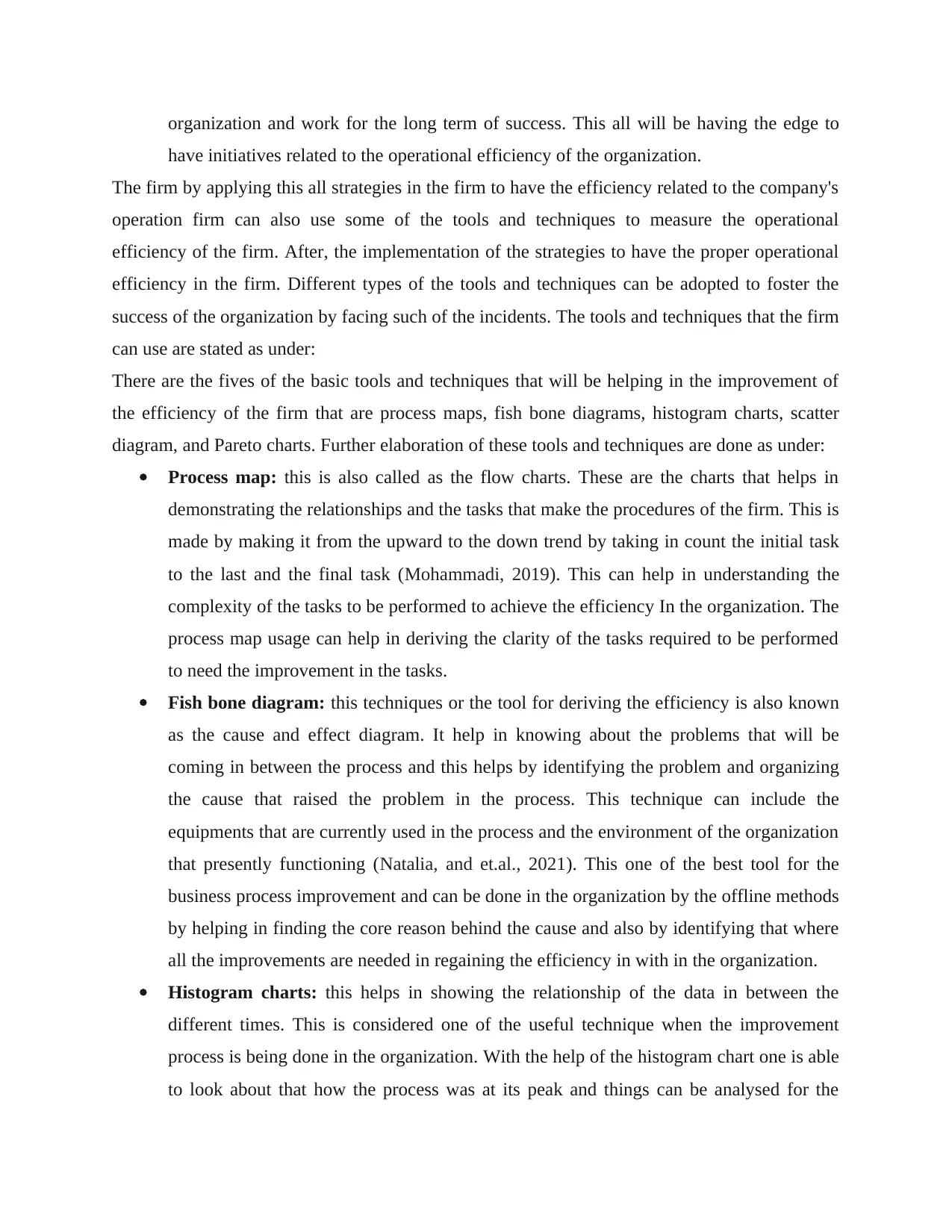
organization and work for the long term of success. This all will be having the edge to
have initiatives related to the operational efficiency of the organization.
The firm by applying this all strategies in the firm to have the efficiency related to the company's
operation firm can also use some of the tools and techniques to measure the operational
efficiency of the firm. After, the implementation of the strategies to have the proper operational
efficiency in the firm. Different types of the tools and techniques can be adopted to foster the
success of the organization by facing such of the incidents. The tools and techniques that the firm
can use are stated as under:
There are the fives of the basic tools and techniques that will be helping in the improvement of
the efficiency of the firm that are process maps, fish bone diagrams, histogram charts, scatter
diagram, and Pareto charts. Further elaboration of these tools and techniques are done as under:
Process map: this is also called as the flow charts. These are the charts that helps in
demonstrating the relationships and the tasks that make the procedures of the firm. This is
made by making it from the upward to the down trend by taking in count the initial task
to the last and the final task (Mohammadi, 2019). This can help in understanding the
complexity of the tasks to be performed to achieve the efficiency In the organization. The
process map usage can help in deriving the clarity of the tasks required to be performed
to need the improvement in the tasks.
Fish bone diagram: this techniques or the tool for deriving the efficiency is also known
as the cause and effect diagram. It help in knowing about the problems that will be
coming in between the process and this helps by identifying the problem and organizing
the cause that raised the problem in the process. This technique can include the
equipments that are currently used in the process and the environment of the organization
that presently functioning (Natalia, and et.al., 2021). This one of the best tool for the
business process improvement and can be done in the organization by the offline methods
by helping in finding the core reason behind the cause and also by identifying that where
all the improvements are needed in regaining the efficiency in with in the organization.
Histogram charts: this helps in showing the relationship of the data in between the
different times. This is considered one of the useful technique when the improvement
process is being done in the organization. With the help of the histogram chart one is able
to look about that how the process was at its peak and things can be analysed for the
have initiatives related to the operational efficiency of the organization.
The firm by applying this all strategies in the firm to have the efficiency related to the company's
operation firm can also use some of the tools and techniques to measure the operational
efficiency of the firm. After, the implementation of the strategies to have the proper operational
efficiency in the firm. Different types of the tools and techniques can be adopted to foster the
success of the organization by facing such of the incidents. The tools and techniques that the firm
can use are stated as under:
There are the fives of the basic tools and techniques that will be helping in the improvement of
the efficiency of the firm that are process maps, fish bone diagrams, histogram charts, scatter
diagram, and Pareto charts. Further elaboration of these tools and techniques are done as under:
Process map: this is also called as the flow charts. These are the charts that helps in
demonstrating the relationships and the tasks that make the procedures of the firm. This is
made by making it from the upward to the down trend by taking in count the initial task
to the last and the final task (Mohammadi, 2019). This can help in understanding the
complexity of the tasks to be performed to achieve the efficiency In the organization. The
process map usage can help in deriving the clarity of the tasks required to be performed
to need the improvement in the tasks.
Fish bone diagram: this techniques or the tool for deriving the efficiency is also known
as the cause and effect diagram. It help in knowing about the problems that will be
coming in between the process and this helps by identifying the problem and organizing
the cause that raised the problem in the process. This technique can include the
equipments that are currently used in the process and the environment of the organization
that presently functioning (Natalia, and et.al., 2021). This one of the best tool for the
business process improvement and can be done in the organization by the offline methods
by helping in finding the core reason behind the cause and also by identifying that where
all the improvements are needed in regaining the efficiency in with in the organization.
Histogram charts: this helps in showing the relationship of the data in between the
different times. This is considered one of the useful technique when the improvement
process is being done in the organization. With the help of the histogram chart one is able
to look about that how the process was at its peak and things can be analysed for the
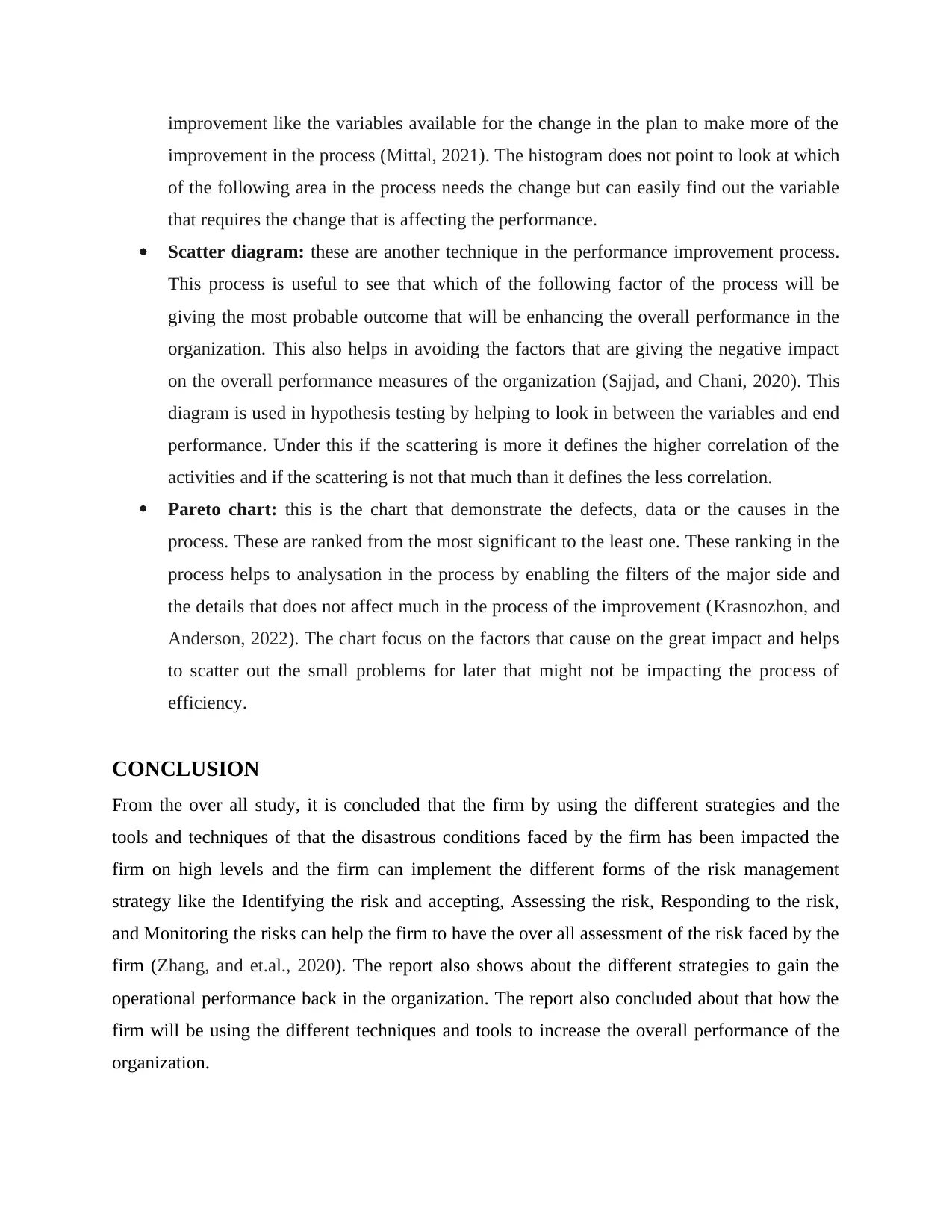
improvement like the variables available for the change in the plan to make more of the
improvement in the process (Mittal, 2021). The histogram does not point to look at which
of the following area in the process needs the change but can easily find out the variable
that requires the change that is affecting the performance.
Scatter diagram: these are another technique in the performance improvement process.
This process is useful to see that which of the following factor of the process will be
giving the most probable outcome that will be enhancing the overall performance in the
organization. This also helps in avoiding the factors that are giving the negative impact
on the overall performance measures of the organization (Sajjad, and Chani, 2020). This
diagram is used in hypothesis testing by helping to look in between the variables and end
performance. Under this if the scattering is more it defines the higher correlation of the
activities and if the scattering is not that much than it defines the less correlation.
Pareto chart: this is the chart that demonstrate the defects, data or the causes in the
process. These are ranked from the most significant to the least one. These ranking in the
process helps to analysation in the process by enabling the filters of the major side and
the details that does not affect much in the process of the improvement (Krasnozhon, and
Anderson, 2022). The chart focus on the factors that cause on the great impact and helps
to scatter out the small problems for later that might not be impacting the process of
efficiency.
CONCLUSION
From the over all study, it is concluded that the firm by using the different strategies and the
tools and techniques of that the disastrous conditions faced by the firm has been impacted the
firm on high levels and the firm can implement the different forms of the risk management
strategy like the Identifying the risk and accepting, Assessing the risk, Responding to the risk,
and Monitoring the risks can help the firm to have the over all assessment of the risk faced by the
firm (Zhang, and et.al., 2020). The report also shows about the different strategies to gain the
operational performance back in the organization. The report also concluded about that how the
firm will be using the different techniques and tools to increase the overall performance of the
organization.
improvement in the process (Mittal, 2021). The histogram does not point to look at which
of the following area in the process needs the change but can easily find out the variable
that requires the change that is affecting the performance.
Scatter diagram: these are another technique in the performance improvement process.
This process is useful to see that which of the following factor of the process will be
giving the most probable outcome that will be enhancing the overall performance in the
organization. This also helps in avoiding the factors that are giving the negative impact
on the overall performance measures of the organization (Sajjad, and Chani, 2020). This
diagram is used in hypothesis testing by helping to look in between the variables and end
performance. Under this if the scattering is more it defines the higher correlation of the
activities and if the scattering is not that much than it defines the less correlation.
Pareto chart: this is the chart that demonstrate the defects, data or the causes in the
process. These are ranked from the most significant to the least one. These ranking in the
process helps to analysation in the process by enabling the filters of the major side and
the details that does not affect much in the process of the improvement (Krasnozhon, and
Anderson, 2022). The chart focus on the factors that cause on the great impact and helps
to scatter out the small problems for later that might not be impacting the process of
efficiency.
CONCLUSION
From the over all study, it is concluded that the firm by using the different strategies and the
tools and techniques of that the disastrous conditions faced by the firm has been impacted the
firm on high levels and the firm can implement the different forms of the risk management
strategy like the Identifying the risk and accepting, Assessing the risk, Responding to the risk,
and Monitoring the risks can help the firm to have the over all assessment of the risk faced by the
firm (Zhang, and et.al., 2020). The report also shows about the different strategies to gain the
operational performance back in the organization. The report also concluded about that how the
firm will be using the different techniques and tools to increase the overall performance of the
organization.
⊘ This is a preview!⊘
Do you want full access?
Subscribe today to unlock all pages.

Trusted by 1+ million students worldwide
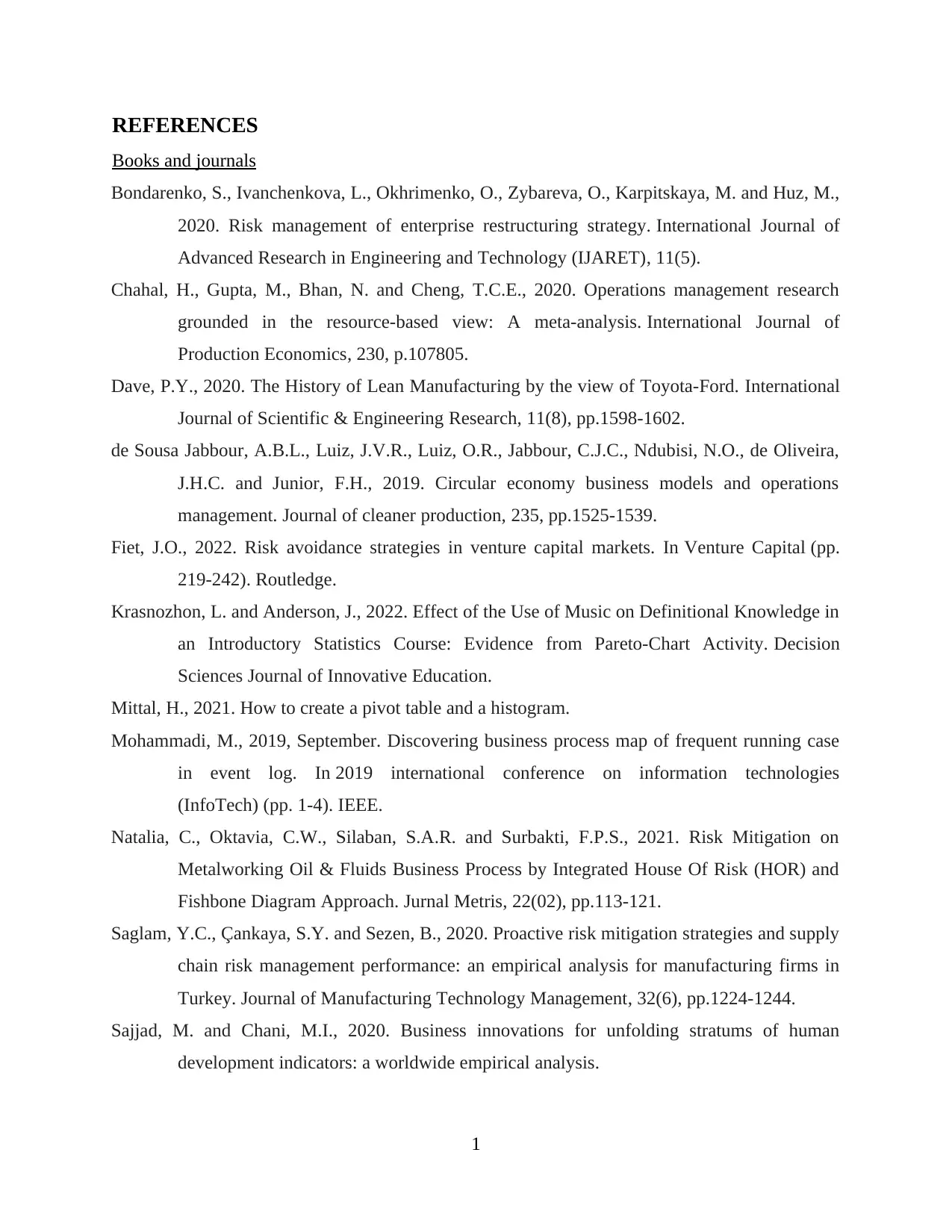
REFERENCES
Books and journals
Bondarenko, S., Ivanchenkova, L., Okhrimenko, O., Zybareva, O., Karpitskaya, M. and Huz, M.,
2020. Risk management of enterprise restructuring strategy. International Journal of
Advanced Research in Engineering and Technology (IJARET), 11(5).
Chahal, H., Gupta, M., Bhan, N. and Cheng, T.C.E., 2020. Operations management research
grounded in the resource-based view: A meta-analysis. International Journal of
Production Economics, 230, p.107805.
Dave, P.Y., 2020. The History of Lean Manufacturing by the view of Toyota-Ford. International
Journal of Scientific & Engineering Research, 11(8), pp.1598-1602.
de Sousa Jabbour, A.B.L., Luiz, J.V.R., Luiz, O.R., Jabbour, C.J.C., Ndubisi, N.O., de Oliveira,
J.H.C. and Junior, F.H., 2019. Circular economy business models and operations
management. Journal of cleaner production, 235, pp.1525-1539.
Fiet, J.O., 2022. Risk avoidance strategies in venture capital markets. In Venture Capital (pp.
219-242). Routledge.
Krasnozhon, L. and Anderson, J., 2022. Effect of the Use of Music on Definitional Knowledge in
an Introductory Statistics Course: Evidence from Pareto-Chart Activity. Decision
Sciences Journal of Innovative Education.
Mittal, H., 2021. How to create a pivot table and a histogram.
Mohammadi, M., 2019, September. Discovering business process map of frequent running case
in event log. In 2019 international conference on information technologies
(InfoTech) (pp. 1-4). IEEE.
Natalia, C., Oktavia, C.W., Silaban, S.A.R. and Surbakti, F.P.S., 2021. Risk Mitigation on
Metalworking Oil & Fluids Business Process by Integrated House Of Risk (HOR) and
Fishbone Diagram Approach. Jurnal Metris, 22(02), pp.113-121.
Saglam, Y.C., Çankaya, S.Y. and Sezen, B., 2020. Proactive risk mitigation strategies and supply
chain risk management performance: an empirical analysis for manufacturing firms in
Turkey. Journal of Manufacturing Technology Management, 32(6), pp.1224-1244.
Sajjad, M. and Chani, M.I., 2020. Business innovations for unfolding stratums of human
development indicators: a worldwide empirical analysis.
1
Books and journals
Bondarenko, S., Ivanchenkova, L., Okhrimenko, O., Zybareva, O., Karpitskaya, M. and Huz, M.,
2020. Risk management of enterprise restructuring strategy. International Journal of
Advanced Research in Engineering and Technology (IJARET), 11(5).
Chahal, H., Gupta, M., Bhan, N. and Cheng, T.C.E., 2020. Operations management research
grounded in the resource-based view: A meta-analysis. International Journal of
Production Economics, 230, p.107805.
Dave, P.Y., 2020. The History of Lean Manufacturing by the view of Toyota-Ford. International
Journal of Scientific & Engineering Research, 11(8), pp.1598-1602.
de Sousa Jabbour, A.B.L., Luiz, J.V.R., Luiz, O.R., Jabbour, C.J.C., Ndubisi, N.O., de Oliveira,
J.H.C. and Junior, F.H., 2019. Circular economy business models and operations
management. Journal of cleaner production, 235, pp.1525-1539.
Fiet, J.O., 2022. Risk avoidance strategies in venture capital markets. In Venture Capital (pp.
219-242). Routledge.
Krasnozhon, L. and Anderson, J., 2022. Effect of the Use of Music on Definitional Knowledge in
an Introductory Statistics Course: Evidence from Pareto-Chart Activity. Decision
Sciences Journal of Innovative Education.
Mittal, H., 2021. How to create a pivot table and a histogram.
Mohammadi, M., 2019, September. Discovering business process map of frequent running case
in event log. In 2019 international conference on information technologies
(InfoTech) (pp. 1-4). IEEE.
Natalia, C., Oktavia, C.W., Silaban, S.A.R. and Surbakti, F.P.S., 2021. Risk Mitigation on
Metalworking Oil & Fluids Business Process by Integrated House Of Risk (HOR) and
Fishbone Diagram Approach. Jurnal Metris, 22(02), pp.113-121.
Saglam, Y.C., Çankaya, S.Y. and Sezen, B., 2020. Proactive risk mitigation strategies and supply
chain risk management performance: an empirical analysis for manufacturing firms in
Turkey. Journal of Manufacturing Technology Management, 32(6), pp.1224-1244.
Sajjad, M. and Chani, M.I., 2020. Business innovations for unfolding stratums of human
development indicators: a worldwide empirical analysis.
1
Paraphrase This Document
Need a fresh take? Get an instant paraphrase of this document with our AI Paraphraser
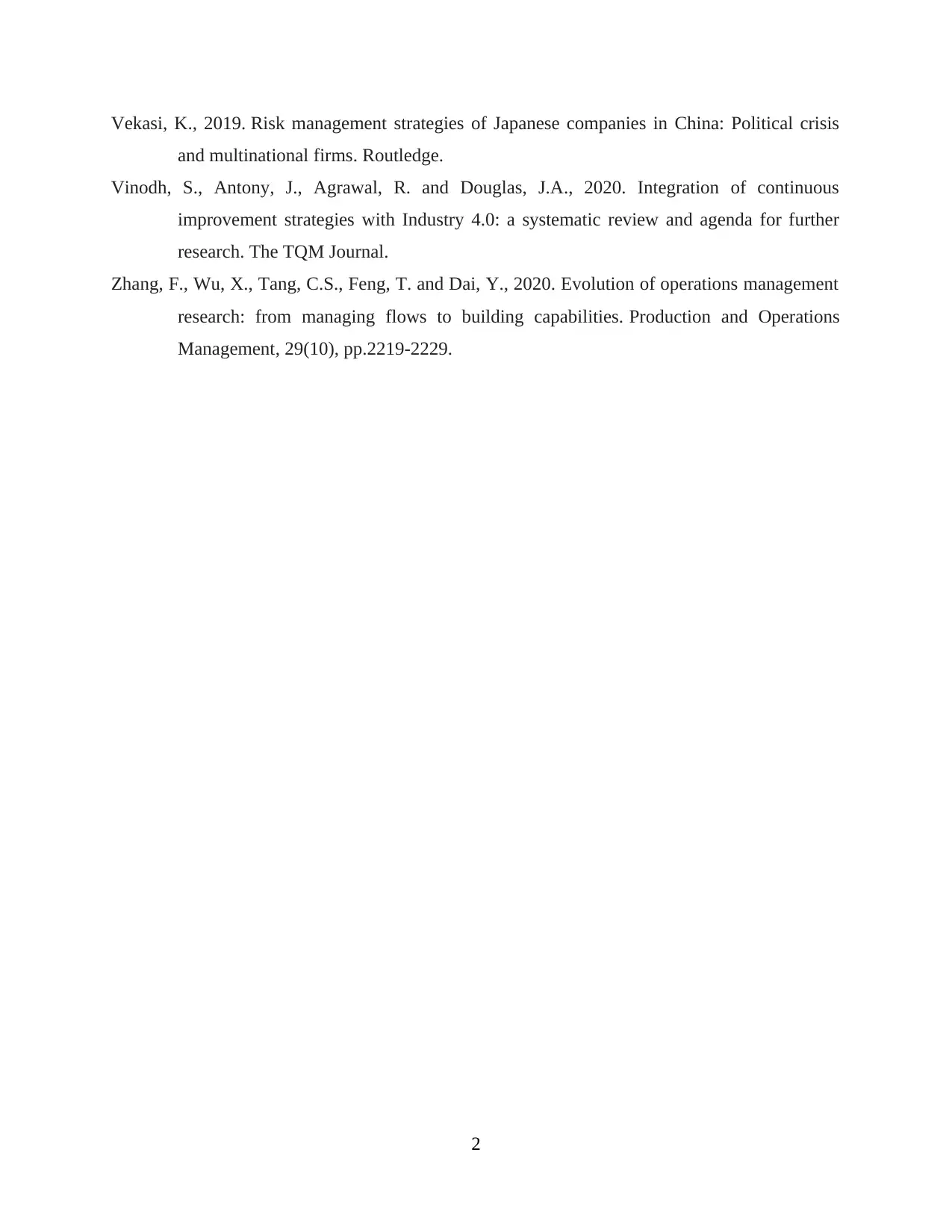
Vekasi, K., 2019. Risk management strategies of Japanese companies in China: Political crisis
and multinational firms. Routledge.
Vinodh, S., Antony, J., Agrawal, R. and Douglas, J.A., 2020. Integration of continuous
improvement strategies with Industry 4.0: a systematic review and agenda for further
research. The TQM Journal.
Zhang, F., Wu, X., Tang, C.S., Feng, T. and Dai, Y., 2020. Evolution of operations management
research: from managing flows to building capabilities. Production and Operations
Management, 29(10), pp.2219-2229.
2
and multinational firms. Routledge.
Vinodh, S., Antony, J., Agrawal, R. and Douglas, J.A., 2020. Integration of continuous
improvement strategies with Industry 4.0: a systematic review and agenda for further
research. The TQM Journal.
Zhang, F., Wu, X., Tang, C.S., Feng, T. and Dai, Y., 2020. Evolution of operations management
research: from managing flows to building capabilities. Production and Operations
Management, 29(10), pp.2219-2229.
2
1 out of 11
Related Documents
Your All-in-One AI-Powered Toolkit for Academic Success.
+13062052269
info@desklib.com
Available 24*7 on WhatsApp / Email
![[object Object]](/_next/static/media/star-bottom.7253800d.svg)
Unlock your academic potential
Copyright © 2020–2025 A2Z Services. All Rights Reserved. Developed and managed by ZUCOL.




